Over the Years
Home > Over the Years > > Conducted a Seminar on Medical Care of A-bomb Survivors in the U.S.
Conducted a Seminar on Medical Care of A-bomb Survivors in the U.S.
Since 1977, the Hiroshima Prefectural Medical Association (HMA) and Hiroshima Prefecture have dispatched delegations for medical examinations of A-bomb survivors residing in North America over a period of more than 30 years, including the period when only HMA was involved in the dispatch program. The program has been showing significant results.
On the other hand, as A-bomb survivors are aging, the need to improve the environment surrounding them is increasing so that they can receive appropriate medical care at ease on a more routine basis.
Accordingly, HICARE conducted a seminar on medical care for A-bomb survivors, targeting medical professionals in the U.S. In addition, we dispatched a delegation of physicians to the U.S. to promote understanding of medical care for A-bomb survivors among local medical professionals. Through the dispatch of a delegation, we also aimed to enhance collaboration with local physicians who play leading roles in the on-site medical care of A-bomb survivors, and to establish a more solid framework for cooperation in dispatching local physicians and other medical professionals to HICARE training.
Period:
Members of the Delegation:
| Shizuteru Usui | Director of HICARE, President of Hiroshima Prefectural Medical Association |
| Hiroo Dohy | President of HICARE, President of Hiroshima Red Cross Hospital and Atomic-Bomb Survivors Hospital |
| Kazunori Kodama | Executive Secretary of HICARE, Chief Scientist of Radiation Effects Research Foundation |
| Makoto Matsumura | Executive Director of Hiroshima Prefectural Medical Association |
| Toru Funaoka | Secretariat of HICARE, Hiroshima City |
| Aki Mochizuki | Secretariat of HICARE, |
On-Site Schedule:
| Date | City | Content |
|---|---|---|
| December 2 (Wed.) | Los Angeles | Visit the Japanese Consulate General in Los Angeles |
| December 3 (Thu.) | Torrance | Hold a seminar at the Doubletree Hotel, Torrance (110 participants) |
| December 4 (Fri.) | Seattle | Meet with members of the Seattle Hiroshima Club (HMA) |
| December 5 (Sat.) | San Francisco | Meet with trainees who previously participated in HICARE training |
| December 6 (Sun.) | San Francisco | Hold a seminar at St. Mary's Medical Center (15 participants) |
| December 7 (Mon.) | San Francisco | Discuss with persons involved |
Reports/Comments:
December 2 (Shizuteru Usui, Director of HICARE, President of the Hiroshima Prefectural Medical Association)
The utmost approach in the major projects of HICARE in fiscal 2009 was to conduct training programs on the medical care of A-bomb survivors for local medical professionals at university hospitals in three cities in North America: Los Angeles, Seattle and San Francisco, which we had not visited for 17 years since the establishment of HICARE. This time, local medical professionals in the U.S., who engage in medical care for radiation exposure at medical institutions or radiation-specialized medical institutes, decided to participate in our training program. Accordingly, six staff members led by myself, Shizuteru Usui, were dispatched to the U.S.
The six members of the delegation consisted of: Hiroo Dohy, President of the Hiroshima Red Cross Hospital & Atomic-bomb Survivors Hospital; Kazunori Kodama, Executive Secretary of HICARE and Chief Scientist of the Radiation Effects Research Foundation; Makoto Matsumura, Executive Director of the Hiroshima Prefectural Medical Association; Shizuteru Usui, Director of HICARE (President of the Hiroshima Prefectural Medical Association); Toru Funaoka from Hiroshima City, Secretariat of HICARE; and Aki Mochizuki from Hiroshima Prefecture and Secretariat of HICARE. We left the Hiroshima Station on December 2 by bullet train and flew from Narita to Los Angeles on the same day.
During the 18 years that have passed since the establishment of HICARE, we have invited many physicians and other medical professionals to Hiroshima from many countries including countries of North and South America, Russia, Ukraine, Kazakhstan and Mongolia, and have provided them with our training. Meanwhile, we did not conduct training programs on medical care for radiation exposure abroad until our first such program in Brazil in 2007. This time we held a seminar in North America, which was the second training program we conducted abroad, following the one in Brazil.
I, Shizuteru Usui, delivered lectures using Power Point at three venues in Torrance (Los Angeles County), Seattle and San Francisco. Under the title "Outline of the Damage Caused by the A-Bomb," I talked about the realities of the terrible devastation of the atomic bombings, including my own experience of radiation exposure. Specifically, my lecture included the following content. Many residents were killed by heat, blast and radiation of the A-bomb. Physicians who survived the Hiroshima A-bombing strove to engage in medical assistant activities, keep records and provide support to A-bomb survivors despite the lack of drugs, efforts which led to the establishment of the Hiroshima A-bomb Casualty Council. This made a great contribution to the medical welfare of the residents of Hiroshima Prefecture. Physicians in Hiroshima are developing the activities of the International Physicians for the Prevention of Nuclear War (IPPNW), which proposes the abolition of nuclear weapons. Moreover, we promote medical examinations of A-bomb survivors residing abroad, from a perspective that "We have to provide the same medical support to A-bomb survivors living in every country because they are still A-bomb victims no matter where they may live in the world."
I would like to come back to the first day. After arriving in Los Angeles, we visited the Japanese Consulate General to extend our gratitude for their cooperation in our campaign. At the meeting, we knew that Consul General Ihara happened to have been in charge of the six-way talks and engaged in discussing the issue of North Korea. Consequently, our meeting continued for an hour, exceeding the scheduled time.
Moreover, Dr. Hunn, CEO of the hospital carrying out medical examinations of A-bomb survivors in Los Angeles and a facilitator of our training program, worked on seeking the cooperation of the U.S. government in Washington D.C. in our mission. He talked excitedly about his hope that our mission would also be carried out on the U.S. budget, not only from funding support from Japan, and that the U.S. version of HICARE would be founded in Torrance City. He said this was because Torrance City comprised the center of important sites in Los Angeles, such as beach areas, airports and the urban center. We discussed a variety of topics, including Japanese immigrants, the difference between American and Japanese food cultures and the American dream, which I will report on another day.
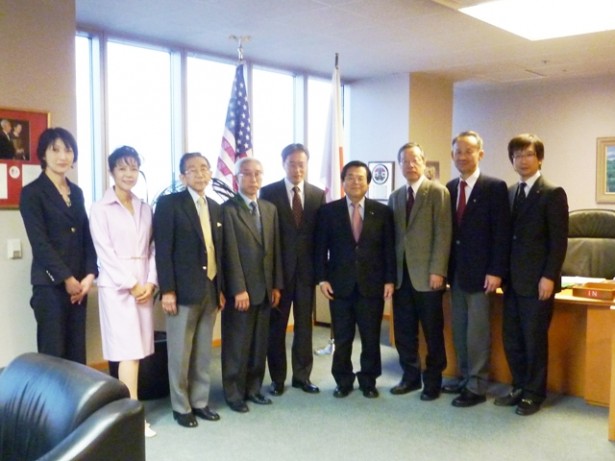
Paying a courtesy call on Mr. Junichi Ihara, Consul General of Japan in Los Angeles (5th from left)
December 3 (Makoto Matsumura, Executive Director of the Hiroshima Prefectural Medical Association)
At 8:30 a.m. on Thursday, December 3, six delegation members led by Dr. Shizuteru Usui cheerfully left the Torrance Marriott South Bay Hotel, where we had stayed on our first night in Los Angeles. Although one was in slightly poor physical condition, the other five members felt well in spite of their long flight of nearly 10 hours the day before (December 2) and the time difference. We arrived at the Doubletree Hotel, the venue of our seminar, after a ten-minute walk. In the hotel lobby, two A-bomb survivors, Ms. Hiroko Nakano and Mr. Joe Ogami, whom we had promised to meet in advance, were already waiting for us. As soon as we met, we offered health consultations. Ms. Nakano, in her 70s, received the 17th medical examination of A-bomb survivors residing in North America in September this year. Since her electrocardiogram showed abnormal indications, she asked for our opinion on the results of the thorough on-site examination. Mr. Ogami, in his 60s, consulted us about the results of his thorough examination regarding anemia, as well as the relationship between the results and his radiation exposure. We explained to both of them that there were no problems. They were satisfied with our opinions.
The venue of the training was arranged in a banquet style setting in a gorgeous room resembling a party room of a hotel, with round tables draped with white tablecloths. The setting was created thanks to the efforts of Mr. Hunn, a local organizer and CEO of the Providence Little Company of Mary Medical Center, and Ms. Deborah Fehn, an on-site supervisor of the seminar and Office Manager of the said Center. She was scheduled to visit Hiroshima for HICARE training in January 2010. At the venue, we found several A-bomb survivors, including Ms. Kazu Sueishi, President of the American Society of A-bomb Survivors and Mr. Sarashina, Director of the said Society, and Dr. Yutaka Sakurai and his wife, who are involved in medical examinations of A-bomb survivors residing in North America. Dr. Freedman, who had worked at the Atomic Bomb Casualty Commission from 1962 to 1964, also attended the training. The number of participants reached 110, including medical professionals, A-bomb survivors and persons involved in disaster crisis management, well exceeding the initial number of applicants of 70. The training program began with a light talk by a moderator, Mr. Scott, who serves as Vice President of the Los Angeles Hospital Association, followed by a greeting by Mr. Hunn on behalf of local organizers. He talked about the significance of the training and their policy of playing a leading role in countering nuclear attacks such as nuclear terrorism in Los Angeles, in collaboration with the federal government. After his greeting, a lecture program started. Lectures were delivered by four speakers with a lunch break in between, followed by a question-and-answer session.
Since I, Matsumura, was the only speaker to give a lecture after the lunch break, I could not eat anything during the lunch. After the lecture, I received several questions including the effects of radiation on soldiers who had been exposed to radiation at nuclear tests in the U.S.
After the training program, we paid a courtesy call on Mayor Scott at the Torrance City Hall under the guidance of Ms. Fehn. We had met Mayor Scott last September when a medical examination was carried out. At that time, he kindly attended a press conference with us, where we passed a personal letter from Mr. Tadatoshi Akiba, Mayor of Hiroshima City, to invite him to participate in the Conference of Mayors for Peace. Although we arrived nearly 10 minutes later than the scheduled time, Mayor Scott gave us a very warm welcome. He showed us around the City Hall on his own and, in particular, happily took a photo of us in the chamber. The Torrance City Council consists of seven members and its assemblies are widely open to the public. With a capacity of several hundred people, the chamber is designed so that the chairs for the mayor and other members could be placed on a platform where they could be moved to facilitate viewing of a screen in the room. We enjoyed talking with Mayor Scott about the mistakes made by the U.S. in pursuing its nuclear strategy in the 1990s, concerns of nuclear terrorism, a sister-city relationship with Kashiwa City in Chiba Prefecture, interaction with Kashiwa City Mayor, visits to Japan, and visits to North Korea by our leader, Usui, resulting in 30-minute delay in the scheduled closing time.
In the evening, we participated in a dinner party hosted by Mr. Hunn. Dr. Mollenkamp and his wife, who had visited Hiroshima two years previously to receive HICARE training, also joined the party. Enjoying delicious dishes and Californian wine, and feeling gratitude for the success of the training program in Torrance, we finished our first day in peace.
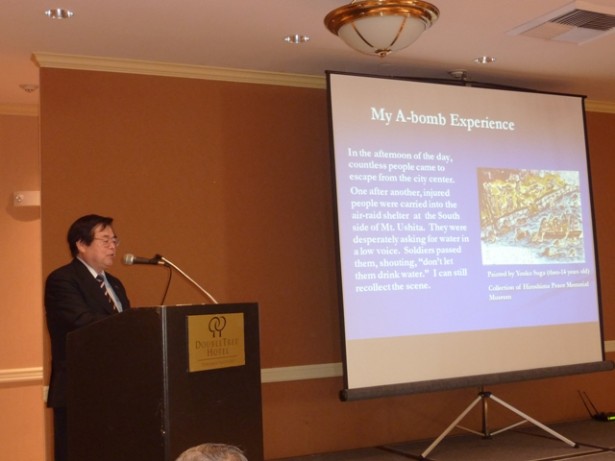
Leader Shizuteru Usui (in Torrance)
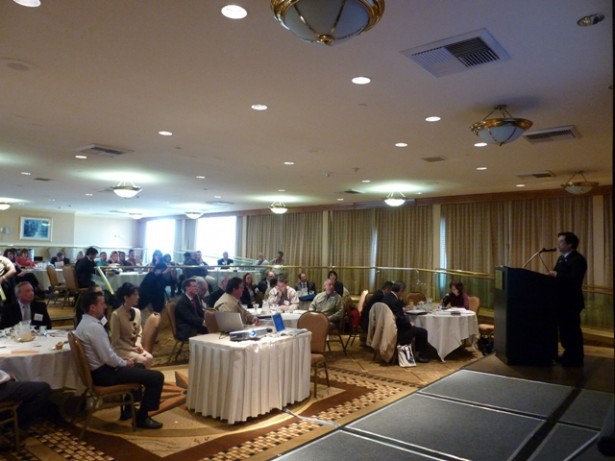
Scene of the seminar (in Torrance)
December 4 (Kazunori Kodama, Executive Secretary of HICARE and Chief Scientist of the Radiation Effects Research Foundation)
On December 4, we left the Los Angeles Airport in the early morning and arrived in Seattle before noon. Soon after our arrival, we headed for the Bluefin Restaurant, the venue for our luncheon, and received a welcome from a total 13 persons including Dr. Namekata, who was in charge of the training program in Seattle, Mr. Nakano, President of Hiroshima Ken-jin Kai (an association of people from Hiroshima Prefecture), and Mr. Tanaka and Mr. Fujita, A-bomb survivors residing in the U.S. After commemorative gifts were presented by Dr.Usui, President of the Hiroshima Prefectural Medical Association (HMA) and Dr. Dohy, President of HICARE, we discussed the arrangements for a seminar to be held at the University of Washington, while enjoying lunch.
Then, after checking in at a hotel and resting for a little while, the delegation of HICARE moved to the Health Care Center of the University of Washington in the evening to attend a seminar held from 18:30 to 21:00.
At the seminar, Dr. Namekata, who led the seminar, delivered his opening address and explained the purpose of the seminar, followed by a greeting from Professor Scott Davis of the University of Washington, who had arranged the venue of the seminar, and then a lecture program.
At first, as one of the lecturers, Dr. Namekata provided a brief overview of the program and a simple explanation of the A-bombings in Hiroshima and Nagasaki and the recent situation regarding global nuclear proliferation. Then, the delegation members of HICARE delivered lectures: a 30-minute lecture titled "Outline of the Damage Caused by the A-Bomb" by Dr. Usui, President of HMA; a 15-minute lecture titled "Activities of HICARE" by Dr. Dohy, President of HICARE; and a 15-minute lecture titled "Issues for the Past 32 Years and Visions of Medical Examinations of A-bomb Survivors Residing in North America" by Dr. Matsumura, Executive Director of HMA. After a 10-minute break, I, Kodama, delivered a lecture under the theme of "Effects of A-bomb Radiation on the Human Body" for 20 minutes. Lastly, Dr. Scott Davis, Professor of Epidemiology at the University of Washington, explained how collaborative research between Japan and the U.S. had been advanced at the School of Public Health, University of Washington and the Radiation Effects Research Foundation, in his 15-minute lecture titled "Partnership Program in Research on Radiation Effects."
The seminar was attended by approximately 50 participants including medical professionals in Seattle, university professors and graduate students of the University of Washington, A-bomb survivors residing in Seattle and members of the Hiroshima Ken-jin Kai. The participants very eagerly listened to the lectures and took notes concerning them. In the question-and-answer sessions after each lecture, participants actively asked questions. Major questions included the following: "Aren't there any other A-bomb survivors in the U.S. who have not been identified yet?"; "How is medical support provided to A-bomb survivors in Japan?"; "Of the cancers that occur in A-bomb survivors, how many are actually caused by the A-bomb radiation?"; "Aren't there many A-bomb survivors who suffer from double cancer?"; and "Does A-bomb radiation cause infertility?"
Although the lecture program was concluded at 9:00 p.m., there were few participants who rose to leave during the program and most of the participants eagerly listened to the lectures till the end. After the lectures, I was asked many questions individually and found it difficult to leave. However, since I had to leave for San Francisco early the following morning, I had no choice but to leave the venue.
Although the seminar was carried out for only a short time, it was very significant in that we were able to provide the participants with the opportunity to learn the real damage of A-bombs and the health effects of radiation, which will last throughout their lives.
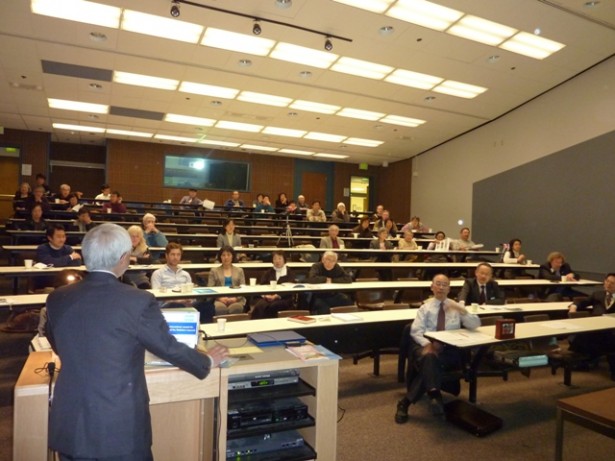
Scene of the seminar (in Seattle)
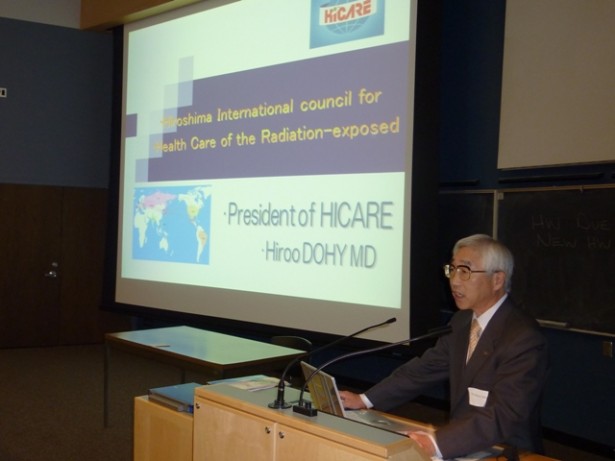
Dr. Hiroo Dohy, President of HICARE (in Seattle)
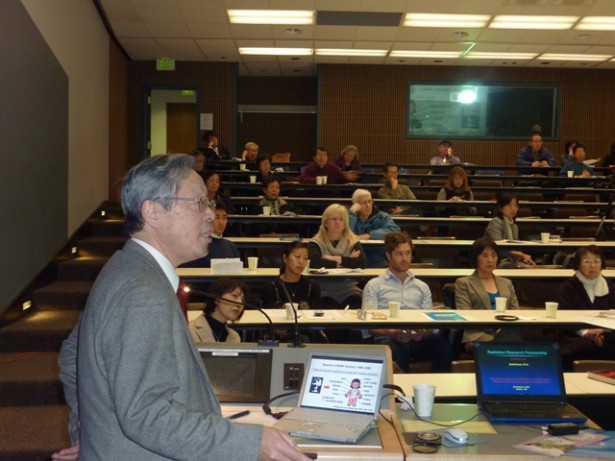
Dr. Kazunori Kodama, a member of the delegation (in Seattle)
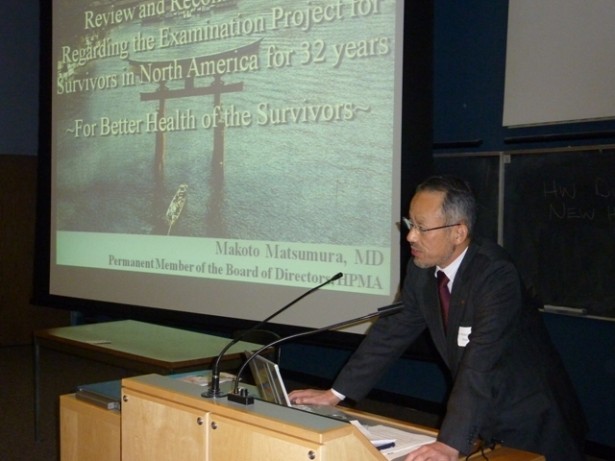
Dr. Makoto Matsumura, a member of the delegation (in Seattle)
December 6 (Hiroo Dohy, President of HICARE and Director of the Hiroshima Red Cross Hospital & Atomic-bomb Survivors Hospital)
On Saturday, December 5, we left Seattle and arrived at San Francisco. After arriving, we took a tour of the city, including taking our lunch, until the evening when a dinner with Dr. Umekubo and Dr. Kei Yatabe was scheduled. Dr. Umekubo visited us at the Hilton Hotel at 5:45 p.m. and took us to a Vietnamese restaurant near the hotel on foot. When he and ourselves, five members altogether, arrived at the restaurant, we saw that 70% of the seats were already occupied and the restaurant was bustling. Leader Usui was seated between Dr. Umeboku and Dr. Yatabe, and I took a seat next to Dr. Yatabe. Dr. Yatabe had visited Hiroshima for HICARE training for a month 13 years before and had taken great care of me when I had visited San Francisco for medical examinations in North America 12 years before. Although I had believed that she was proficient in Japanese, I realized that this was my groundless assumption and that she had received her HICARE training mostly in English. Since Dr. Umekubo, a third-generation Japanese American, only spoke English, we all talked in English during the dinner.
Since I tend to become talkative after drinking, the English conversation at the dinner became a very good opportunity for me to practice speaking English for my presentation the following day. After enjoying talking about various topics including our past experiences, which seemed to continue endlessly, we returned to the hotel, each of us vowing the success of the seminar to be held on the following day.
On the following day, December 6, we spent the morning resting and making preparations for the seminar, and headed for St. Mary's Medical Center, the seminar venue, at noon. The lectures had the same content as the previous ones that had been delivered at the two previous venues, and were as follows:
1.An outline of the damage caused by the A-bombs by Leader Shizuteru Usui
2.The establishment and overview of HICARE, and an explanation about the situation of A-bomb survivors residing abroad and changes thereof by Hiroo Doi
3.The reality of disorder after A-bomb radiation exposure by Kazunori Kodama, Chief Scientist of the Radiation Effects Research Foundation
4.The 32-year history of medical examinations in North America and future visions by Makoto Matsumura, Executive Director of HMA
The seminar was attended by approximately 15 participants, which was small in scale compared to the seminar with 110 participants held in Los Angeles and that with 50 participants held in Seattle. However, the participants of the seminar in San Francisco were all medical experts. In a discussion session after the lectures, many tough questions were asked and the discussion continued for nearly 30 minutes. In this regard, I believed that the seminar was the most fruitful and satisfactory of all.
The following day, we organized the materials that we used in the seminar and returned home on Tuesday.
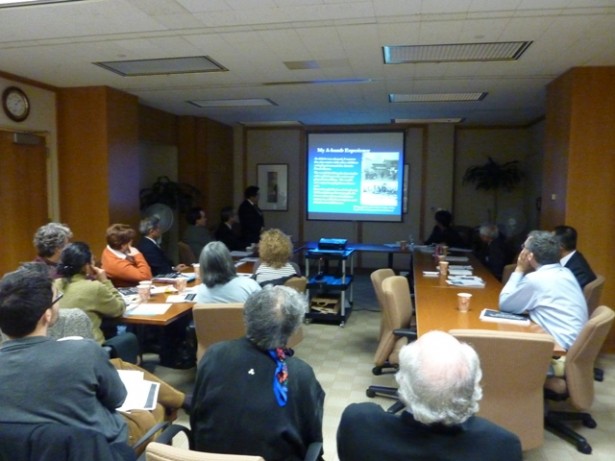
Scene of the seminar (in San Francisco)




